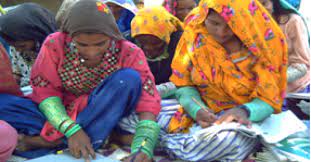
There are thousands of schools closed and more than 3 million children out of school in Sindh while ravages of Covid-19 have kept schools closed for almost 2 years, which has plunged education sector in a deep ravine leaving the children of the poorest in precarious situation.
By Gulsher Panhwer
Some time back speakers in a small and remote village of Thano Bola Khan had vowed to impart adult literacy to around 20000 females in age brackets of 16 years and above in remote villages of Dadu and Jamshoro Districts of Sindh, which was a uphill task indeed but if there is will there is way.
Pakistan is among the countries of region having the lowest literacy rate of 60 percent. China has 96 percent literacy rate while even the tiny states like Nepal and Bhutan boast of 67 and 68 percent of literacy ratio, and the Bangladesh who parted the ways from Pakistan in 1971 has succeeded in making its 75 citizens literate.
Being a proud Islamic democratic nation, we have never felt tired to announce ambitious plans to eradicate literacy in unrealistic time period. And yet, citizens are deprived of education despite constitutional guaranties – Articles 25 and 37 envisage that every citizen has right to free education from grade one to ten.
But things at ground have gone from bad to worse and dividends of democracy have only benefited affluent classes who afford and avail expensive high quality education from private schools and universities in Pakistan and abroad.
Sindh province of Pakistan, despite having more stable provincial government and one party’s dominance, particularly since 2008, has miserably failed in improving education and literacy.
No doubt PPP government is proactive in legislation and announcing reforms in education sector but universal literacy rate still seems a distant dream.
There are thousands of schools closed and more than 3 million children out of school in Sindh while ravages of Covid-19 have kept schools closed for almost 2 years, which has plunged education sector in a deep ravine leaving the children of the poorest in precarious situation.
According to UNESCO there is the worst condition of education at primary schools in Sindh whereby 46% (2.8 million) students who are 5 to 9 years old desperately experience dropout in primary Schools, and, on the other 38% of children leave school without completion of education at primary school level.
In all, such a dismal situation in our education system, female education is still worst and in rural parts of Sindh, the girls’ education is nearly non-existent.
In such a scenario when formal education system is in shambles, female adult literacy initiative is desperately needed. Literacy department of Sindh government, Thardeep Rural Development Program, National Commission for Human Development (NCHD) and some other non-governmental actors have expected the challenge of reaching out to these females who due to various reasons could not avail basic education.
As a child of 5, I remember how my father joined other enthusiastic young and old men to rush in evening hours to learn read and write in nearby adult literacy center during mid-1970s.
But with martyrdom of Prime Minister Zulfiqar Ali Bhutto, the excellent initiative of adult literacy collapsed. ‘Nai Roshini’ schools launched by Prime Minister Muhammad Khan Jonejo in mid-1980s met with same fate.
NCHD has continued on the path of imparting adult literacy. The new initiative launched in two districts of Sindh, Jamshoro and Dadu is a joint venture of Sindh government, TRDP, NCHD. Sindh government is providing support to NCHD who have vast experience in curriculum development and running the adult literacy center across the country while TRDP has women organization from local to district level. Thus this initiative has good chance of success. The teachers, supervisors and taluka Coordinators have been locally hired and trained. I visited around 10 centers in Dadu district and majority of these centers are being run properly.
With consultation of the leaners, time was set according to their choice and adult females come to the centers for three hours’ time after completing their house hold chores. The leaners are being imparted reading, writing, numerical and life skills. One learner shared that this is grand opportunity for her. She said, “I do cotton picking. As the man shows less weight of the cotton, we get less paid, but after learning reading, writing and numerical skills I will be able to get proper weight and proper wages from my picked cotton.”
Another woman from village Dhotra Panhwar of Dadu District said that despite sending the children to best school they are for behind in their school attainment in comparison to children whose mothers are literate. “After gaining literacy from this center, I will be able to help my children in their education,” she said.
Another woman said that due to her activism, her village organization offered her leadership position but she is unable to maintain record of her village organization and seeks help from her fellow women. “Now, after availing the literacy she would be able to maintain record.”
Thus women have clear ideas ranging from reading expiry dates of medicines, saving themselves from price exploitation, starting and running small business etc. after gaining literacy skills.
_____________________
Gulsher Panhwer is a freelance writer mostly touching the environmental, cultural and such other issues. He can be reached at gulsherp@yahoo.com